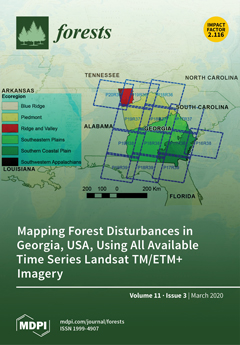Silvicultural practices such as pre-commercial thinning (PCT) and repeated fertilization have been used successfully around the world to increase forest biomass for conventional wood products, biofuels, and carbon sequestration. Two complementary studies were designed to test the hypotheses (H) that large-scale PCT and PCT with repeated fertilization of young (13–17 years old) lodgepole pine (
Pinus contorta var.
latifolia) stands, at 25 years after the onset of treatments, would enhance (H
1) productivity and structural features (diameter and height growth, crown volume and dimensions) of crop trees; (H
2) merchantable volume of crop trees, (H
3) abundance of understory conifer, herb and shrub layers, and (H
4) carbon storage (sequestration) of all layers. Results are from two studies in south-central British Columbia, Canada. The PCT study had three densities: 500, 1000, and 2000 stems/ha, an unthinned, and old-growth stand replicated at three areas. The PCT-FERT study had four densities: 250, 500, 1000, and 2000 stems/ha with and without a repeated fertilization treatment, and an unthinned-unfertilized stand, replicated at two areas. Heavily thinned (≤1000 stems/ha) and fertilized stands generally had larger mean diameters and crown dimensions than lightly thinned or unfertilized stands, whereas mean heights of crop trees remained relatively unaffected, and hence partial support for H
1. Despite differences in stand density (4- and 8-fold) of original crop trees, ingress of intermediate crop trees over the 25 years changed density dramatically. There was no support for H
2, as mean merchantable volume of total crop trees was similar across stand densities owing to ingress, and was also similar in fertilized and unfertilized stands. In stands thinned to ≤500 trees/ha, there is an anticipated increase in crop tree density of 2.2 to 4.3 times over 25 years compared with the original post-thinning densities. Mean abundance of understory conifers was generally similar among stands owing to successional development towards canopy closure, whereas herbs and shrubs persisted only in canopy gaps in heavily thinned stands, thereby providing no support for H
3. Mean carbon storage was similar across densities in both studies with ingress contributing a considerable amount to carbon sequestration at the lower densities. Fertilization increased (1.4 times) mean carbon storage significantly among total crop trees, total conifers, and the grand total of all layers, thereby providing partial support for H
4. Thus, much of the potential above-ground carbon storage lost by thinning was restored in the heavily thinned stands at 25 years post-treatment.
Full article





